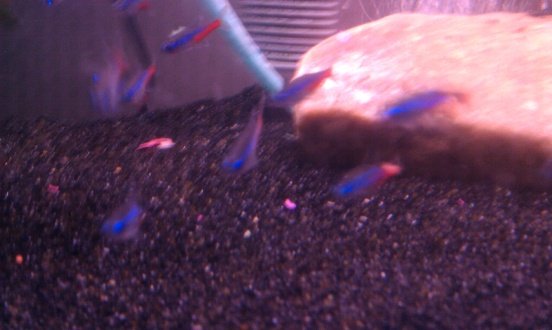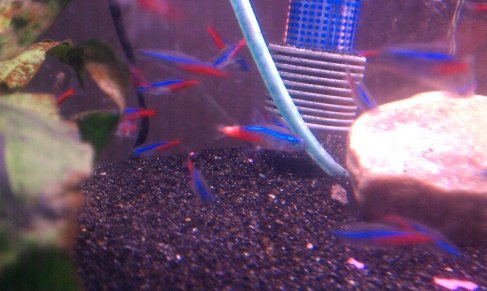In my tank I have a school of about 12 neons plus many other fish. I have not had many problems with my neons and I make sure that along with flakes they get micro pellets to eat.
Well anyways let me say neons are tricky cause they are easy to care for but delicate.
"Disease
Unfortunately, neon tetras are occasionally afflicted by the so-called "Neon Tetra Disease" (NTD) or
Pleistophora, a
sporozoan disease caused by
Pleistophora hyphessobryconis. Despite being a well-known condition, it is currently incurable and often fatal to the fish.
The disease cycle begins when
microsporidian parasite spores enter the fish after it consumes infected material such as the bodies of a dead fish, or
live food such as
tubifex, which may serve as
intermediate hosts. The disease is most likely to be passed on from newly acquired fish, which have not been quarantined.
Symptoms:
- Restlessness.
- Fish begins to lose coloration.
- As cysts develop, the body may become lumpy.
- Fish has difficulty swimming.
- In advanced cases the spine may become curved.
- Secondary infections such as fin rot and bloating.
Note that there is a so-called "
false neon disease", which is bacterial, and shows very similar symptoms. It is impossible for the home aquarist to determine for certain the difference between NTD and false NTD on the basis of visible symptoms alone, without laboratory backup. This disease has also been confused with
Columnaris (mouth rot, mouth fungus, 'flex').
To date, there is no known cure: the only 'treatment' is the immediate removal of diseased fish to preserve the remaining fish, but no way to save the diseased fish. The use of a
diatom filter, which can reduce the number of free parasites in the water, may help." - Wikipedia
Neon tetra - Wikipedia, the free encyclopedia
Now one thing with neons that people will notice is that in the morning when lights are first turned on a lot of fish including neons will be pail. Withing about 15 minutes there color will be brighter and in about 30 minutes the color will be very bright and healthy looking. This is normal.
" Their colour and the iridescent stripe may become dim at night, and can be virtually invisible after a period of darkness. The color may also fade during a period of stress, such as human intervention into the tank. Neons are best kept in a densely planted tank with subdued light and an ideal temperature of 21–27 °C (70–81 °F) to resemble their native Amazon environment." - Wikipedia
Neon tetra - Wikipedia, the free encyclopedia



